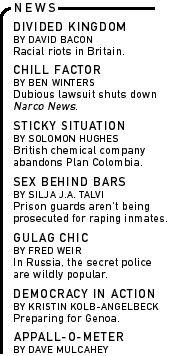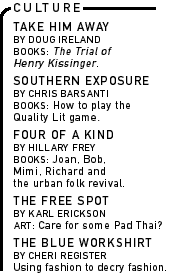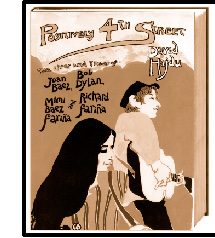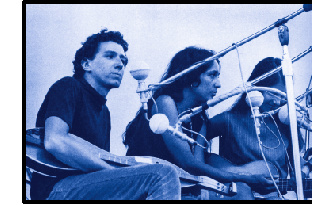|
|

|

|

|
|
|
| |
|
||
|
Positively 4th Street Washington Square Memoirs In the late spring of 1954, a 13-year-old Joan Baez and her 9-year-old sister Mimi went to see traveling troubadour Pete Seeger perform at Palo Alto High School. The concert was a benefit for the California Democratic Party, but Seeger, who'd been blacklisted from major concert halls, was using the event for his own mission--to teach his fans how to assert their power as individuals through music. "We don't need professional singers," Seeger coached. "We don't need stars. You can sing." Although his political point eluded young Joan and Mimi, at least a part of Seeger's message reached them both. After the concert, their Aunt Tia remembered, "Mimi and Joan both announced that they decided they wanted to sing." So the sisters got guitars and worked on their voices. Joan went on to become queen
Let me warn you--this essay is not about that old fuzzyhead Bob Dylan. David Hajdu's fantastic Positively 4th Street: The Life and Times of Joan Baez, Bob Dylan, Mimi Baez Fariña and Richard Fariña--which I'm sure is (to borrow a word from Fariña) the grooviest book I'll ever get to write about--tells the engaging story of the way these four lives intersected at one cultural moment, not how three of them revolved around Dylan. Still, reviews have tended to focus on the haggard bard, coupling Hajdu's book with one or more of the other tie-ins to Dylan's 60th birthday: Howard Sounes' new biography Down the Highway, Clinton Heylin's updated Bob Dylan: Behind the Shades Revisited or the DVD reissue of Dont Look Back. Generally, it has been concluded that Dylan is a liar, genius and sublime jerk who royally screwed over Joan Baez but made some really great records so, hey hey, it's all right. But there's so much more to the story. Let's start with Fariña. Post-college, he wandered through New York City, cruising Village haunts like the Folklore Center and Folk City, drinking with the "writers" at the White Horse Tavern and toting around a little black book filled with telephone numbers of "people with pads." Inevitably, he met Carolyn Hester, the beautiful queen of the folk scene in the pre-Baez era. It was 1960; he was hanging at the White Horse, she was dining there with the ridiculously influential--and corrupt--New York Times folk music critic Robert Shelton. Since "it was Dick's nature," as Fariña's Village buddy Kirkpatrick Sale put it, "to find the most attractive thing and go after it," Fariña went straight for Hester, marrying her just 18 days after that first meeting. This union made Fariña an auxiliary member of the folk scene, which was rapidly evolving. What began as a disorganized group of kids strumming away their weekends in Washington Square Park had turned into, oddly enough, a market. Clubs, coffeehouses, record labels, music publishers and shops were prospering, while performers were getting more professional. Woody Guthrie, Blind Lemon Jefferson, Leadbelly and Odetta were succeeded by middle-class kids making the once-earthy music sound polished and pretty. Peter, Paul and Mary were put together by Albert Grossman (who would become Bob Dylan's manager) and Joan Baez was on a quick rise. The folk craze--filling in the big blank space between those early, promising sounds of rock and the arrival of the Beatles--was even making its way to Europe. In the winter of 1962, Fariña made his way to Europe too, by boat. When Hester followed him a month later by plane, she was shocked to find him famous in London--not as a writer, but as a dulcimer-playing folk singer. Hester, feeling Fariña was stepping on her turf, was pissed. In an effort to make up, Fariña suggested taking a romantic trip to Paris. Enter Mimi Baez, who was living with her mother and father in Paris, struggling to finish high school through correspondence courses. One afternoon, she was invited to a picnic with her sometime boyfriend Todd Stuart, Fariña, Hester, John Cooke (of the Charles River Valley Boys) and Scottish folksinger Alex Campbell. But Fariña's charms, always laid on thick, weren't muffled a bit by the presence of Hester or Stuart. "At one point," remembered Mimi, "[Fariña] was telling stories and carrying on and getting us laughing. ... I laughed so hard that I threw up my sandwich in his face!" Hester left Paris for the United States shortly after that afternoon; Fariña went back to London. Their marriage was all but officially over. In London, Fariña maintained a constant
party in a borrowed home with artist/ Around this time, Hajdu notes, Joan sent Mimi a batch of records
from her new home in California's Carmel Highlands. When The
Freewheelin' Bob Dylan arrived, it had a note clipped to the
sleeve declaring, "My new boyfriend." Mimi played the record for
Richard, who liked the songs, but heard them as a challenge--the
first of many, in Richard's mind, to be issued by Dylan. Although
he was still at work on his novel, he began plotting his next course
to fame: songwriting and performing with his new That summer, Mimi and Richard joined Joan in Carmel. In September, when Dylan
Although Dylan went back to New York after about a month, the bond between him and Joan strengthened, even as their politics began to differ. (Rather, Joan got her politics and Bob stopped pretending that he had any to start with.) Mimi and Richard were making music too; they eventually put out their own record with Vanguard, Celebrations for a Grey Day. Joan, to the extent she allowed herself, supported them; she performed one of Fariña's more political songs, "Birmingham Sunday," to her consistently enormous crowds. And for a short while, life was bliss. In a letter to her mother, Joan even reported that she and Dylan "have such fun! Wow and he takes baths and everything." For another month, the foursome's party shifted across the country to Albert Grossman's house in upstate New York. Then the inevitable crash. When Dylan--who by this point had become hugely famous riding on Joan's ever available back--mentioned that he was meeting with a book editor about publishing some of his prose-poems (eventually released as Tarantula), Fariña, who'd been pounding on his own manuscript for years, was furious. He went for a long walk to calm down and came back covered in mud. "He was terribly upset," remembered Mimi. "He never let himself look that messy." (The ever-vain Fariña actually had his blue jeans dry-cleaned and pressed.) Meanwhile, Bob and Joan's dual concert tour of the East Coast went miserably; Dylan, forsaking his protest-song roots for the hard-driving, personal compositions on his new record Bringing It All Back Home, alienated both audiences and Baez, who had finally hooked into Pete Seeger's plan and was regularly devoting a part of her performance time to speaking out for peace. Even though she ended up accompanying Dylan on his tour through Great Britain in 1964 (a torturous time documented in D.A. Pennebaker's cinéma-vérité masterpiece Dont Look Back), the end had pretty much arrived for folk's royal couple. Writing off the very scene he rode in on, Dylan expressed his feelings this way: "Folk music," he told the Times' Shelton, "is a bunch of fat people." Ultimately, Fariña triumphed over Dylan in prose, publishing the raucous novel Been Down So Long It Looks Like Up to Me with Random House in 1966. It's a roller coaster of a book, winding together a campus in revolt, a search for true love and lots of drugs through an unrestrained, beat-like narrative; Thomas Pynchon, Fariña's friend from college, described the book as "com[ing] on like the Hallelujah Chorus done by 200 kazoo players with perfect pitch." But even as Fariña felt the relief of success, his marriage to Mimi slid downhill. She felt helpless to change her lot--Richard never taught her to drive a car, allowed her to have a checkbook or even to read her own mail--while her husband and sister became an inseparable pair, deciding to record a rock album together with Richard as producer. (Joan, thankfully, came to her senses and refused to release the record.) One evening after a book signing, Fariña threw a surprise party for Mimi's 21st birthday. During the festivities, but only after changing into a pair of hip-hugging blue jeans, he went for a motorcycle ride with another party guest, from which he never returned. Before he died in the crash, however, Fariña had left the idea for his next book to settle with his editor, Jim Silberman; it would be a memoir of his times with Mimi, Joan and Bob. Positively 4th Street is great for what it is: a glimpse into four lives at a certain time, no strings attached. A lot of stars, both bright and dim, from the Cambridge and Greenwich Village scenes pass through Hajdu's pages too. But the deep roots of the movement are only glossed over. Harry Smith, whose Anthology of American Folk Music is the most important collection in this vein, is conspicuously absent, as is, for the most part, Woody Guthrie, who inspired Dylan early on to write a song that went, get this, "Hey hey Woody Guthrie, I wrote you a song." If you're curious about what the revival actually sounded like, listen to the aptly titled Washington Square Memoirs, a new boxed set from Rhino. Spanning three compact discs, it's a good survey of the sounds of the time. Starting with Guthrie, Odetta and Seeger and moving though Hester, Phil Ochs, Judy Collins and Peter, Paul and Mary, you can really hear how the times in the folk scene were a-changin'. As a straight listen, however, it's a little tough going. The revival's big tent included English ballads that singers like Baez drew upon, hillbillyish knee-slappers and the protest songs that most of us associate with the peace movement--with lots of hybrids in between--so the collection lacks the musical consistency and mood that allows a record to really move a listener. The transitions from song to song are jarring, and the inability of some folks to actually sing is, well, remarkable. Bob and Joan are represented by two ballads, among the best in
the box; Richard and Mimi are present with "Pack Up Your Sorrows."
Their songs are spaced apart on the collection, unconnected. But
after reading Positively 4th Street, it's impossible to hear
them that way. Here's Joan, showing Bob her politics; there's Richard
and Mimi trying to catch up with Joan. And then Bob, represented
by a love song, with no indication that he would soon plug in, turn
around and write a scathing sort of tune that would sum up everything
for him exactly: "Love Is Just a Four Letter Word." Hillary Frey is assistant literary editor of The Nation.
|





